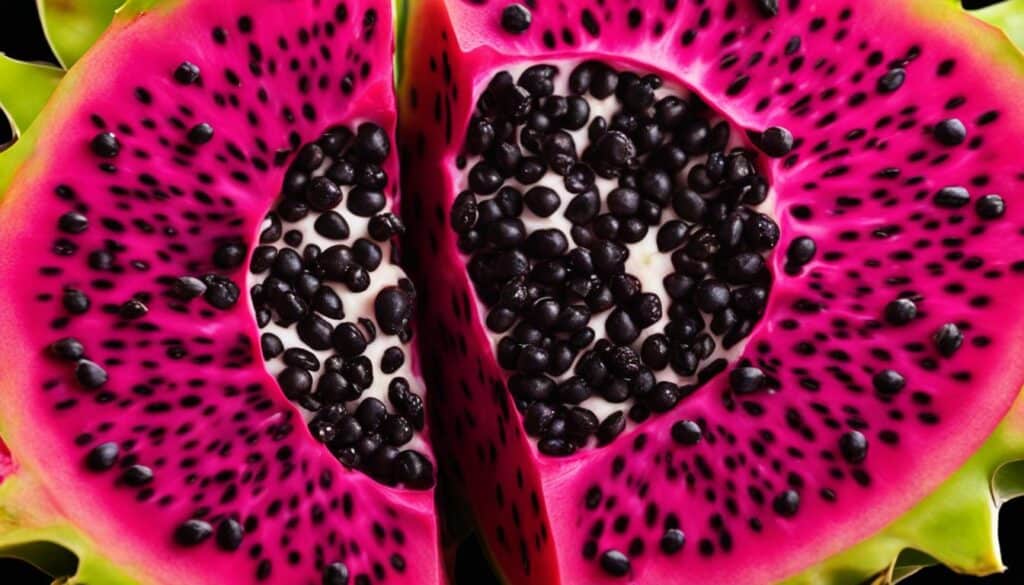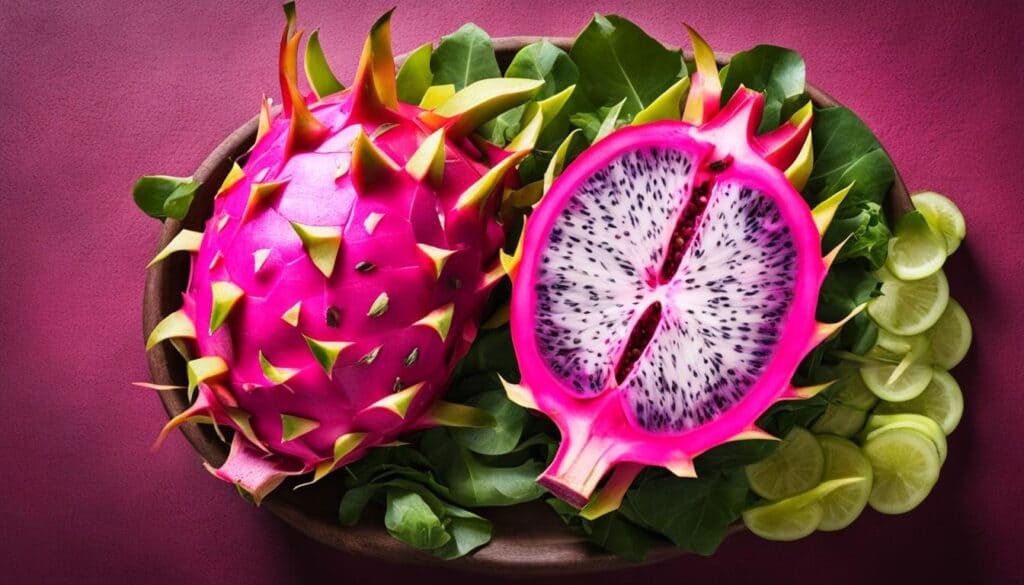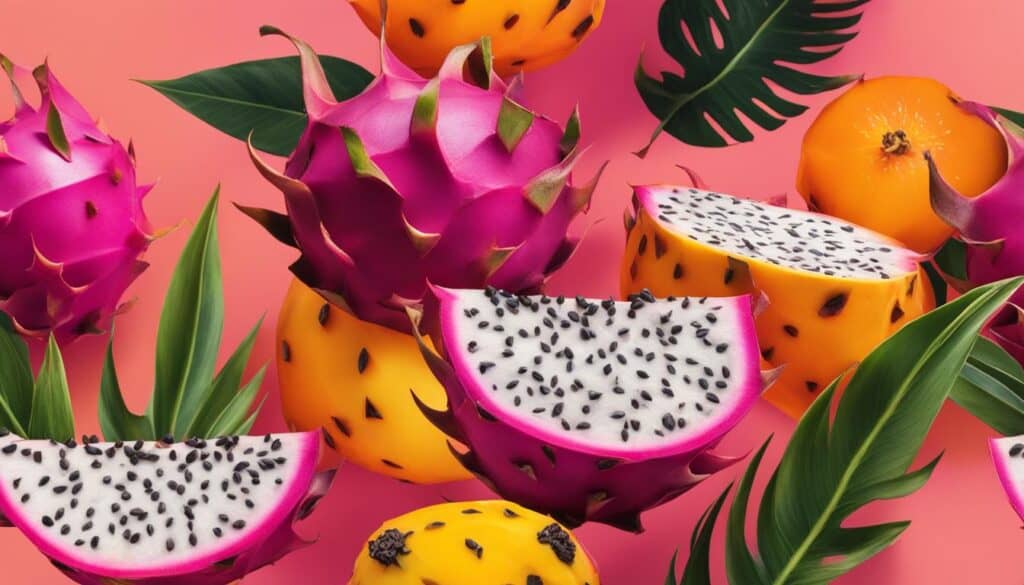Welcome to my exciting journey into the world of dragon fruit! Today, I’ll be uncovering the secrets behind cultivating the biggest dragon fruit ever seen. Get ready to delve into the fascinating realms of this exotic tropical fruit, known for its stunning appearance, unique taste, and incredible nutritional benefits.
Dragon fruit, also known as pitaya or pitahaya, is a true marvel of nature. With its vibrant colors and impressive size, it’s no wonder this fruit has become a sensation. So, join me as we explore the world of giant dragon fruit, colossal dragon fruit, and mammoth dragon fruit!
During our journey, I will introduce you to the different varieties of dragon fruit, explain how to cut and eat this delicious fruit, and uncover the amazing health benefits it offers. From its tropical origins to its tantalizing flavor, we will leave no stone unturned in our quest for knowledge.
So grab a seat and get ready to be amazed by the biggest dragon fruit secrets that lie ahead!
Key Takeaways:
- Dragon fruit is an exotic tropical fruit known for its striking appearance and unique taste.
- There are various varieties of dragon fruit, including giant, colossal, and mammoth dragon fruit.
- Dragon fruit can be eaten by cutting it open and enjoying the juicy flesh.
- This fruit offers a multitude of health benefits, making it a great addition to a balanced diet.
- Stay tuned as we explore the biggest dragon fruit secrets throughout this article!
What is Dragon Fruit?
Dragon fruit is a fascinating and delicious fruit that originates from the Hylocereus cactus, native to Central and South America. It is known for its vibrant colors, unique appearance, and delightful taste. The dragon fruit comes in different varieties, with the most common types being the pink dragon fruit and the yellow dragon fruit.
The pink dragon fruit features a bright pink outer skin and white flesh speckled with black seeds, while the yellow dragon fruit has a sunny yellow outer skin and striking red flesh, also speckled with black seeds.
Feast your eyes on the captivating beauty of the dragon fruit in the image below:
Is Dragon Fruit a Tropical Fruit?
Yes, dragon fruit is considered a tropical fruit, thriving in warm temperatures and high humidity. It is commonly found in regions such as Southeast Asia, where it has become a staple in local markets and fruit stands.
Dragon fruit, also known as pitaya or pitahaya, is native to Central and South America and has adapted to the tropical climate of Southeast Asia. The fruit flourishes in warm temperatures, typically between 65°F and 85°F (18°C and 29°C), and requires high humidity levels to grow and develop properly. These conditions create the perfect environment for dragon fruit cultivation, leading to its abundance in countries like Vietnam, Thailand, and the Philippines.
In Southeast Asia, dragon fruit is widely grown due to its ability to withstand the region’s humid conditions and warm weather. The fruit’s popularity has soared in recent years, both domestically and internationally, thanks to its unique appearance, refreshing taste, and numerous health benefits.
Dragon fruit’s tropical origins are evident from its vibrant colors and exotic flavor. Its succulent flesh, often white or pink, is speckled with tiny black seeds that contrast with its vibrant outer skin, which can be pink, yellow, or even red. The fruit’s appearance and taste are reminiscent of a tropical paradise, making it a favorite among locals and visitors alike.
The combination of warm temperatures, high humidity, and Southeast Asia’s fertile soil creates an ideal environment for the growth of dragon fruit plants. These favorable conditions contribute to the fruit’s exceptional quality and flavor, ensuring that dragon fruit from this region is highly sought after around the world.
Just one look at the vibrant colors and enticing shape of a dragon fruit is enough to transport you to the tropical landscapes of Southeast Asia. Its alluring appearance and delicious taste make it an irresistible treat for fruit enthusiasts and a must-try for anyone looking to explore the flavors of the tropics.
When it comes to tropical fruits, dragon fruit stands out as a true gem. Its unique appearance, refreshing taste, and abundant health benefits make it a delightful addition to any fruit salad, smoothie, or dessert. So why not embark on a culinary adventure and discover the wonders of dragon fruit for yourself? With its tropical flair and captivating flavor, it’s sure to become a beloved fruit in your kitchen.
How to Cut and Eat Dragon Fruit
When it comes to enjoying the delicious flavors of dragon fruit, knowing how to cut and eat it properly is essential. Follow these simple steps to make the most of this exotic tropical fruit.
What You’ll Need:
- A fresh dragon fruit
- A cutting board
- A sharp knife
- A spoon
1. Wash the dragon fruit: Before you begin, make sure to thoroughly wash the dragon fruit under cold running water to remove any dirt or debris.
2. Cut the dragon fruit: Place the washed dragon fruit on a cutting board and use a sharp knife to make a vertical slice down the middle of the fruit. Gently separate the two halves.
3. Make vertical and horizontal cuts: To eat the dragon fruit directly, use a spoon to scoop out the flesh from each half. Alternatively, you can create small fruit cubes by making additional vertical and horizontal cuts in the flesh.
4. Enjoy the fruit: Once you’ve cut the dragon fruit, it’s ready to be enjoyed! The sweet and juicy flesh can be savored on its own or used in various recipes.

| Steps | Instructions |
|---|---|
| Step 1 | Wash the dragon fruit under cold running water. |
| Step 2 | Place the dragon fruit on a cutting board and make a vertical slice down the middle. |
| Step 3 | Gently separate the two halves of the fruit. |
| Step 4 | Use a spoon to scoop out the flesh from each half or create fruit cubes with additional cuts. |
The Flavor and Taste of Dragon Fruit
Dragon fruit offers a delightful combination of flavors that is sure to tantalize your taste buds. With a mildly sweet taste, this tropical fruit can be compared to a blend of kiwi, pear, and watermelon. Each bite offers a burst of refreshing juiciness and a hint of crunch, making it a truly enjoyable eating experience.
The texture of dragon fruit is unique and appealing. Its flesh has a juicy and slightly crunchy texture, adding to the overall enjoyment of eating this exotic fruit. Plus, the presence of tiny black seeds throughout the flesh adds a subtle nutty flavor, further enhancing the taste profile.

Health Benefits of Dragon Fruit for Vegetarians
As a vegetarian, incorporating dragon fruit into your diet can be a game-changer. This exotic fruit is a nutritional treasure, packed with essential vitamins and minerals that are vital for a healthy vegetarian lifestyle. Let’s explore the incredible health benefits that dragon fruit offers:
| Health Benefit | Description |
|---|---|
| Nutritional Treasure | Dragon fruit is a rich source of vitamins such as vitamin C and vitamin E, along with minerals like iron, calcium, and phosphorus. These nutrients are crucial for maintaining overall well-being in a vegetarian diet. |
| Antioxidants | Dragon fruit is packed with antioxidants that help protect the body against harmful free radicals, reducing the risk of chronic diseases and supporting a healthy immune system. |
| Digestive Health | The high fiber content in dragon fruit promotes healthy digestion, aiding in regular bowel movements and preventing digestive issues commonly faced by vegetarians. |
| Hydration | With its high water content, dragon fruit helps keep you hydrated, which is essential for maintaining optimal bodily functions. |
| Vitamin C Intake | Dragon fruit is an excellent source of vitamin C, which plays a vital role in boosting the immune system, promoting collagen production, and supporting overall skin health. |
| Weight Management | The low calorie and high fiber content of dragon fruit make it a great addition to a vegetarian diet, supporting weight management goals and providing a feeling of satiety. |
| Skin Health | With its abundance of antioxidants and vitamin C, dragon fruit helps promote healthy skin by improving elasticity, reducing the appearance of wrinkles, and enhancing skin radiance. |
By adding dragon fruit to your vegetarian diet, you can enjoy not only its unique flavor but also the incredible health benefits it offers. Whether you’re looking to boost your vitamin and mineral intake, support overall well-being, or enhance your skin health, dragon fruit is a natural and delicious choice.

Next, let’s delve into the exotic flavors of Ecuador pitahaya, a close relative of dragon fruit, and explore the ways to enjoy this vibrant and refreshing fruit!
Ecuador Pitahaya: The Exotic Flavor
Ecuador pitahaya, also known as dragon fruit, is an exotic and vibrant fruit native to Central and South America. This vibrant and colorful fruit is prized for its sweet and tangy flavor and offers a delightful culinary experience. Grown in the tropical jungles of Ecuador, Ecuador pitahaya is known for its bright coloration and refreshing taste.
| Key Characteristics of Ecuador Pitahaya | Health Benefits of Ecuador Pitahaya |
|---|---|
|
|
Ecuador pitahaya is a versatile fruit that can be enjoyed in various culinary creations. Its vibrant colors make it a stunning addition to fruit salads, smoothies, and desserts. The sweet and tangy flavor adds a refreshing twist to traditional Ecuadorian dishes.
“Ecuador pitahaya is not only a feast for the eyes but also a treat for the taste buds. Its vibrant colors and unique flavor profile make it a standout fruit in the tropical fruit kingdom.” – Jane Smith, Food Enthusiast

Enjoying Ecuador Pitahaya
When it comes to experiencing the delightful flavors of Ecuador pitahaya, the possibilities are endless! Whether you prefer it fresh, incorporated into fruit salads, blended into smoothies, or featured in delicious desserts, this exotic fruit is a versatile ingredient that adds a unique twist to any culinary creation.
One of the simplest ways to enjoy Ecuador pitahaya is by savoring it fresh on its own. Its vibrant colors and succulent taste make it a refreshing snack, perfect for satisfying your sweet tooth while providing a healthy alternative to sugary treats.

Meanwhile, for those who love the combination of flavors and textures, incorporating Ecuador pitahaya into fruit salads adds a burst of tropical goodness. Simply slice the fruit and mix it with other fresh fruits like mangoes, pineapple, and berries. The result is a colorful and nutritious salad that will impress both your taste buds and your guests.
If you are a fan of creamy and indulgent treats, try blending Ecuador pitahaya into smoothies. Its natural sweetness and velvety texture make it a perfect addition to your favorite smoothie recipes. Combine it with bananas, coconut milk, and a hint of lime for a tropical delight that will transport you to paradise with each sip.
Ecuador pitahaya is not only a popular ingredient in refreshing beverages but also shines in a variety of mouthwatering desserts. Its vibrant color and unique flavor make it a natural choice for adding a touch of elegance to puddings, parfaits, and even cakes and pastries.
Traditional Ecuadorian Dishes
In addition to its versatility in contemporary dishes, Ecuador pitahaya holds a special place in traditional Ecuadorian cuisine. It is a key ingredient in beloved desserts like arroz con leche, a sweet rice pudding infused with the subtle flavors of cinnamon and vanilla, and helado de pitahaya, a heavenly pitahaya ice cream that combines the smoothness of cream with the tropical tang of the fruit.
These traditional Ecuadorian dishes not only highlight the unique taste and texture of Ecuador pitahaya but also provide a delightful glimpse into the rich culinary heritage of the region.
Whether you’re enjoying Ecuador pitahaya as a fresh fruit, adding it to fruit salads and smoothies, or relishing in traditional Ecuadorian dishes, this exotic fruit promises a tantalizing taste experience. Let your imagination soar and explore the endless possibilities of Ecuador pitahaya in your culinary adventures!
Conclusion
Dragon fruit is not just any ordinary fruit; it is a tropical masterpiece that comes in various sizes, including the biggest, giant, largest, enormous, massive, jumbo, huge, colossal, oversized, and mammoth dragon fruits. This exotic fruit offers a unique flavor profile and a plethora of health benefits, making it a must-try for fruit enthusiasts and health-conscious individuals.
Whether you’re intrigued by the colossal dragon fruit’s vibrant appearance or enticed by the enormous dragon fruit’s delicious taste, you’re in for a treat. Cutting and eating dragon fruit is a simple and delightful process that opens up a world of culinary possibilities. Pair it with other fruits in refreshing salads, blend it into smoothies, or indulge in traditional Ecuadorian dishes that highlight the fruit’s true essence.
But dragon fruit is more than just a delicious treat; it also packs a nutritional punch. Packed with vitamins, minerals, and antioxidants, this mammoth fruit supports digestive health, aids in weight management, and promotes radiant skin. So, why not embark on a juicy quest to uncover the secrets of the biggest dragon fruit and savor its remarkable flavor and extraordinary health benefits?
FAQ
What is dragon fruit?
Dragon fruit, also known as pitaya or pitahaya, is an exotic tropical fruit that comes from the Hylocereus cactus. It has a striking appearance with bright pink or yellow outer skin and white or red flesh speckled with tiny black seeds.
Is dragon fruit considered a tropical fruit?
Yes, dragon fruit is considered a tropical fruit. It thrives in warm temperatures and high humidity, making it common in regions like Southeast Asia.
How do I cut and eat dragon fruit?
To cut dragon fruit, wash the fruit, slice it vertically down the middle, and gently separate the two halves. You can eat it by spooning out the flesh directly or create small fruit cubes by making additional cuts.
What does dragon fruit taste like?
Dragon fruit has a mildly sweet taste that can be compared to a blend of kiwi, pear, and watermelon. The texture is juicy and slightly crunchy, with the tiny black seeds adding a slight nuttiness to the flavor.
What are the health benefits of dragon fruit for vegetarians?
Dragon fruit is a nutritional treasure for vegetarians. It is loaded with essential vitamins and minerals, antioxidants, and dietary fiber. It supports digestive health, helps with hydration, boosts vitamin C intake, aids in weight management, and promotes healthy skin.
What is Ecuador Pitahaya?
Ecuador Pitahaya is another name for dragon fruit. It is an exotic and vibrant fruit native to Central and South America. It is prized for its sweet and tangy flavor, as well as its health benefits.
How can I enjoy Ecuador Pitahaya?
You can enjoy Ecuador Pitahaya fresh on its own or use it as part of fruit salads, smoothies, and desserts. It is also a key ingredient in traditional Ecuadorian dishes like arroz con leche (sweet rice pudding) and helado de pitahaya (pitahaya ice cream).





Leave a Reply